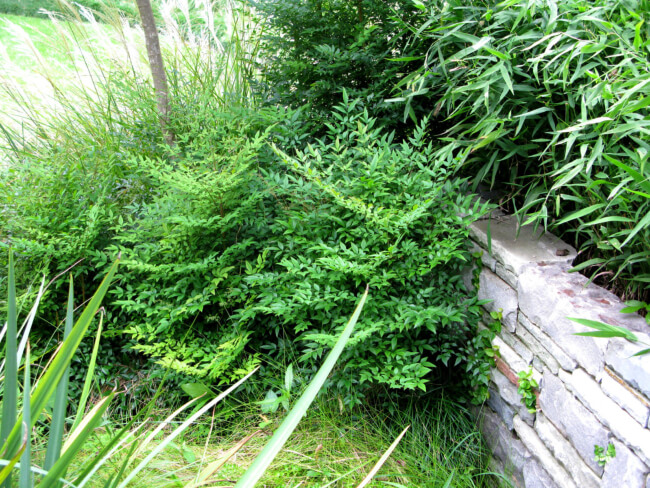If you’re after indestructible, structural, and beautiful planting, Nandina is a pretty safe bet. Its gorgeous spring foliage is bright red, holding that pigmentation right through summer, and only slightly fading through winter.
In the right soil, with good sun, nandina will establish quickly, and rapidly become one of the most important plants in your garden. To make sure you give it the right start in life, follow our guide to growing in Australia, and you won’t go wrong.
More...
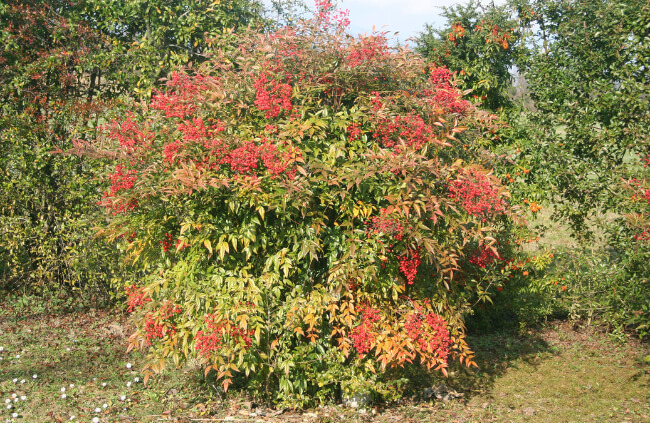
Family: | Berberidaceae |
|---|---|
Genus: | Nandina |
Species: | N. domestica |
Origin: | Eastern Asia |
Common Names: | Nandina, Sacred Bamboo, Heavenly Bamboo |
Location: | Outdoor |
Type: | Shrub |
Growth: | 2m x 2m (best pruned to 1m x 1m) |
Sun requirements: | Full sun or light shade |
Foliage Colour: | Green, new growth is vibrant red |
Flower Colour: | White |
Flowering: | Summer |
Edible Parts: | None |
Maintenance level: | Low |
Poisonous for pets: | All parts of Nandina are poisonous |
What is Nandina?
In the most basic terms, Nandina is a highly attractive ornamental shrub, with delicate foliage showing vibrant reds and oranges when new growth emerges. Nandina, or Nandina domestica, is a common garden shrub, but one that is widely misunderstood, and misused.
Its common names, heavenly bamboo or sacred bamboo, lead many to believe it grows as a grass, in woodlands, or in shade. While the plant does do reasonably well in some dappled shade, it much prefers bright light or even full sun.
The most prominent characteristics of nandina are its leaf colour, papery lightness, and bright winter berries – though these are known to be toxic to birds, and should be removed if native birds do show interest in them.
Natural Habitat of Nandina domestica
Nandina is most associated with Japan but grows naturally throughout eastern Asia, from the Himalayas, right through to central Japan. In nearly all cases it is found on forest fringes, where it grows on fairly poor soil, and in full, direct sun.
In our gardens, it’s really quite easy to replicate those conditions, by planting nandina in any bright location, without much regard for the soil.
Best Nandina Varieties to Grow in Australia
Nandina domestica, as a pure, true-to-species plant is pretty much perfect, but plant breeders have spent years trying to perfect perfection.
The results are mixed, and often quite hard to tell apart, but there are some stand-out cultivars of Nandina domestica that are well worth considering for a pop of colour in your shrub borders, or as a base to annual planting.
1. Nandina ‘Blush Pink’One common criticism of nandina is that it’s actually quite samey. Despite its vividly colourful foliage, it sprouts in spring and stays pretty much red all year, until new leaves emerge in spring. Nandina ‘Blush Pink’ offers something a little different, with gentle pink foliage as they open out, deepening to red in summer, and finally a bold and rich orange glow right through winter. |  Source: The Sunset Plant Collection |
2. Nandina ‘Brightlight’Like anything in the Berberis family, of which Nandina is part, colour is everything. It’s also surprisingly easy to breed, so this lime green cultivar of a species known for bright red leaves is distinct and unusual. Rather than adding depth to borders, this nandina pops right to the front, brightening up slightly shady spots in the garden. | 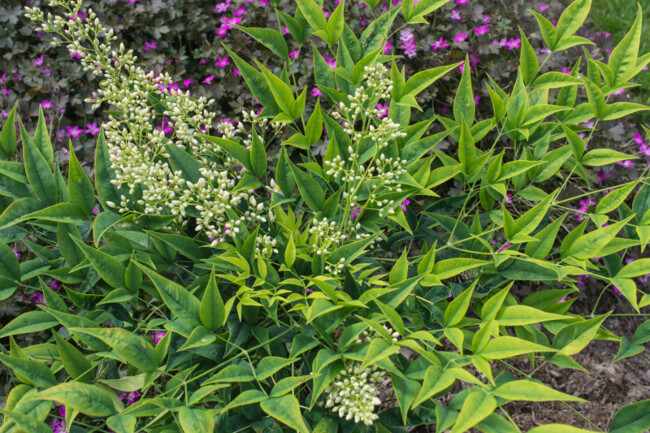 Source: rezeau.org |
3. Nandina ‘Filamentosa’All the elegance of Acer palmatum, without any of the fuss. Thread Leaf Nandina, as it's generally known, has fine, needle-like leaves, bred into fine filaments, which bristle in the wind, and turn the richest or reds through winter. Unlike Japanese maples, Nandina ‘Filamentosa’ can cope with wind, and won’t mind being baked, or shaded. |  Source: Flower Power |
4. Nandina ‘Firepower’A compact, semi-evergreen, cultivar, Nandina ‘Firepower’ offers something most can’t. It will limit itself, and respond incredibly well to tight clipping. For formal hedging, or topiary with a twist, Firepower offers spectacular colour, as well as tidy form. | 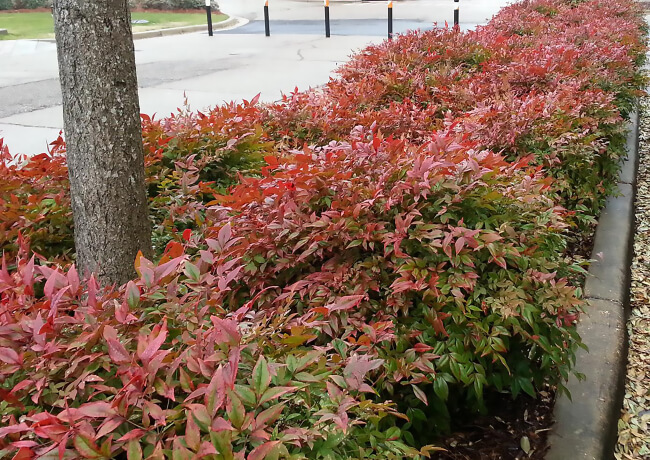 Source: Ball Australia |
5. Nandina ‘Flirt’ / ‘Murasaki’Also called Murasaki, Nandina ‘Flirt’ is a pale, powdery nandina with a neat, compact dome, typically reaching about 1.5m tall. For a neat base to a pastel toned flower border, there are few easier shrubs to work into a garden design than Nandina ‘Flirt’. | 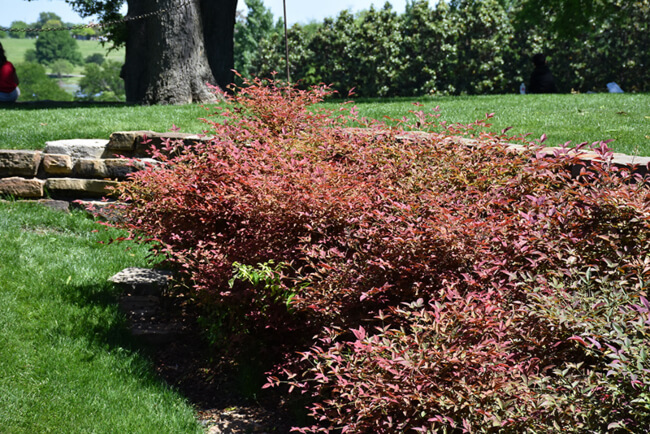 Source: Buchanan's Native Plants |
6. Nandina ‘Gulf Stream’Much like the gulf stream itself, Nandina ‘Gulf Stream’ works best in swathes and waves, undulating through shrubby backdrops to your garden. Alternatively, plant Nandina ‘Gulf Stream’ as a hedge, and prune the base into a standard to offer planting options around its base. The unruly top growth breaks up the tops of fences, while its relatively easy-going nutrient needs mean you can grow most annuals from seed quite well around its base. |  Source: Andreasens Green |
7. Nandina‘Harbour Dwarf’Blue-green foliage, with pink-hued tips adorn this self-limiting shrub, which grows to a height of 1m if left to its own devices, but works best pruned into a low groundcover shrub or about 30cm. Like most tight-knit shrubs, it makes excellent formal topiary balls, either in borders, or gravel gardens to add structure and formality without the fuss. | 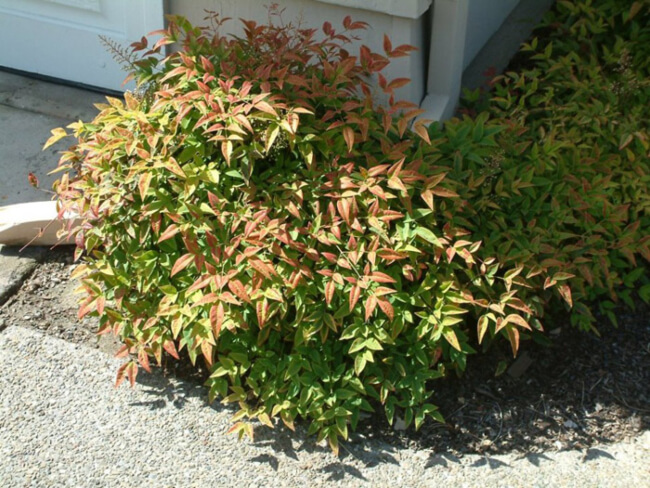 Source: El Paso Desert Blooms |
8. Nandina ‘Lemon-Lime’Lemon lime is one of the most garishly green shrubs you could possibly plant in your garden, but because of that, it’s sort of perfect. Nothing else will provide such year-round vibrancy, bringing you back into spring even in the darkest and gloomiest of winter nights. |  Source: Flower Power |
9. Nandina ‘Magical Sunrise’Purple rather than red, Magical sunrise has that warm glow of humid spring mornings. For most of the year it’s a gentle orange-green, but as winter comes around, it warms up any garden design instantly, whether it’s left to its own devices as a tall but loose shrub, or clipped into formal styles. |  Source: Gardening Express |
10. Nandina ‘Moon Bay’From a distance, this straw-like mass of foliage could easily be mistaken for summer heather, and it offers something similar, but without the fire hazard. The soft, hay-bale-yellow leaves set their green backing off perfectly, creating rough, natural, depth that looks incredible in pots, or planted by itself near the pool to break up hard landscaping. | |
11. Nandina ‘Moyer’s Red’Moyer’s Red is a shockingly gorgeous winter shrub, particularly in cooler climates, where its berries fight off the frost with a burst of colour from the other end of the garden. This nandina can be grown in loose groups, and left to provide dappled screening, or, like most, clipped into tighter hedging. | 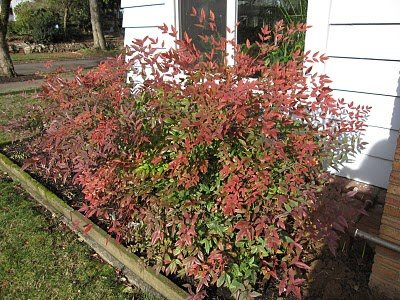 Source: Plant Lust |
12. Nandina ‘Obsessed’ / ‘Obsession’One of the deepest reds you’ll find, even with Nandina domestica cultivars, is Nandina ‘Obsessed’, whose winter foliage is so vibrant that you’d be forgiven for mistaking it for blooms. The rose-red clusters or tightly packed foliage on clipped Nandina ‘Obsessed’ (also called ‘Obsession’) are unlike anything else in the winter garden. | 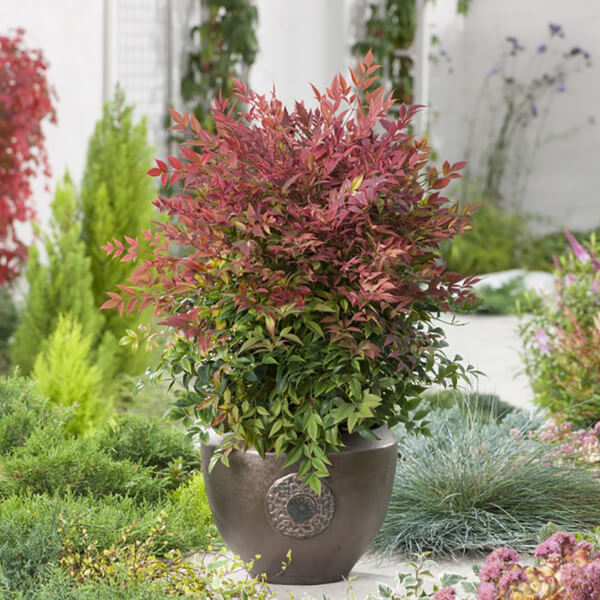 Source: Everglades Nurseries |
13. Nandina ‘Richmond’Nandina ‘Richmond’ wasn’t selected for its foliage, it was created, and selectively bred for its flower. More particularly, its buds. Like all nandina, its flowers open from conical clusters of pale flower buds, but ‘Richmond’ offers pastel pink personality to those buds, as well as gently staggered berries, adding interest for longer in the year than any of its counterparts. | 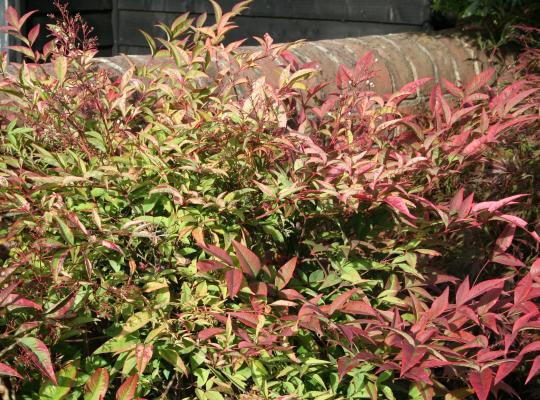 Source: North Hill Nurseries |
14. Nandina ‘Royal Princess’Reaching up to 3m tall, this swaying nandina offers bold blooms and year-round colour, as well as the potential to prune and lift the canopy into a gorgeous small tree. | |
15. Nandina ‘Sienna Sunrise’Elongated red blades emerge in spring, deepening to blood red tones through winter, as the grassy mound forming Nandina ‘Sienna Sunrise’ establishes and earns its keep in the garden. In a light breeze on a sunny day, the sound of this bristling plant will transport you to the seaside in seconds. | 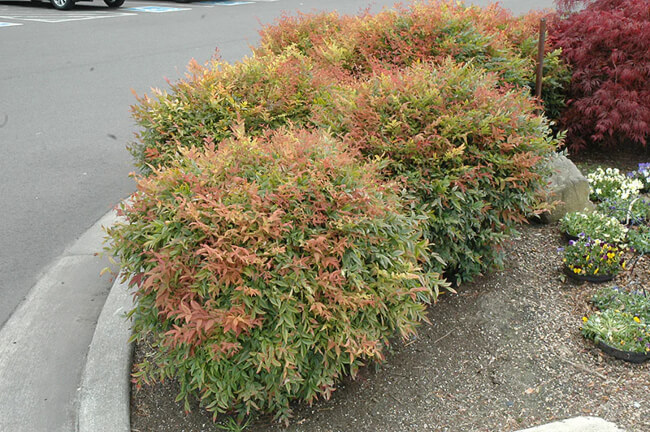 Source: Green Thumb Nurseries |
16. Nandina ‘Summer Sunset’Burgundy leaves, with mottled mid ribs create layer canopies to these woody shrubs. Crown lifted and planted against boundaries they provide nesting spots, depth, and dappled light to go with the subtle privacy they offer too. | 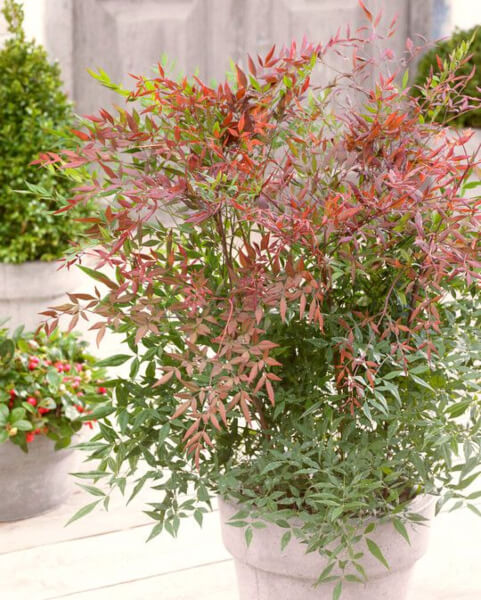 Source: Peter Nyssen |
17. Nandina ‘Sunset Boulevard’Short, coral coloured leaves make this compact and low-growing shrub interesting enough, but when you add in its gorgeous bright red winter berries, there are few better shrubs for containers, either on balconies or patios that offer the sort of colour and seasonal interest that Nandina ‘Sunset Boulevard’ can. | 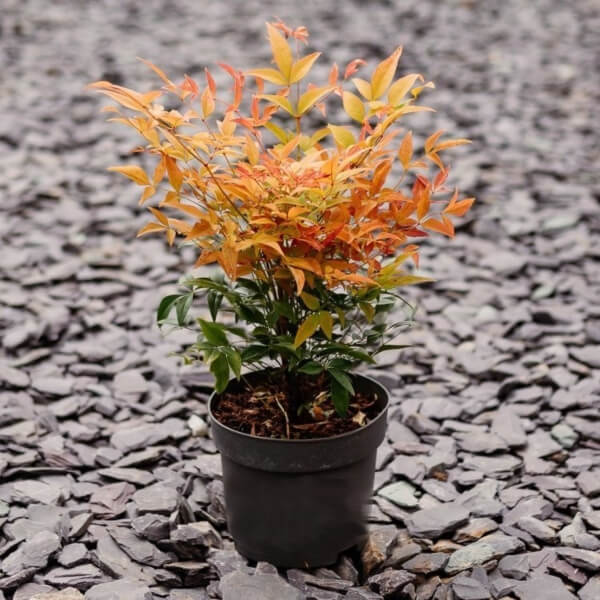 Source: Gardening Express |
18. Nandina ‘Twilight’Nandina ‘Twilight’ was one of the first shrubs I planted in my garden. It’s generally thought of as a compact, clippable shrub, but we’ve allowed it to grow up past the fence, shading the patio in summer, and offering some neighbourly privacy (both ways). Its spectacular pale pink, variegated foliage is like nothing else I’ve ever come across, at least not with the same dappled, rustling light qualities it brings to your garden. | 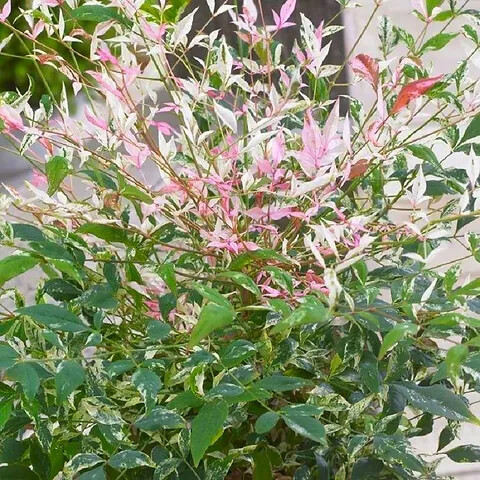 Source: Ever Green Gardens |
1. Nandina ‘Blush Pink’

Source: The Sunset Plant Collection
One common criticism of nandina is that it’s actually quite samey. Despite its vividly colourful foliage, it sprouts in spring and stays pretty much red all year, until new leaves emerge in spring.
Nandina ‘Blush Pink’ offers something a little different, with gentle pink foliage as they open out, deepening to red in summer, and finally a bold and rich orange glow right through winter.
2. Nandina ‘Brightlight’

Source: rezeau.org
Like anything in the Berberis family, of which Nandina is part, colour is everything. It’s also surprisingly easy to breed, so this lime green cultivar of a species known for bright red leaves is distinct and unusual.
Rather than adding depth to borders, this nandina pops right to the front, brightening up slightly shady spots in the garden.
3. Nandina ‘Filamentosa’

Source: Flower Power
All the elegance of Acer palmatum, without any of the fuss. Thread Leaf Nandina, as it's generally known, has fine, needle-like leaves, bred into fine filaments, which bristle in the wind, and turn the richest or reds through winter.
Unlike Japanese maples, Nandina ‘Filamentosa’ can cope with wind, and won’t mind being baked, or shaded.
4. Nandina ‘Firepower’

Source: Ball Australia
A compact, semi-evergreen, cultivar, Nandina ‘Firepower’ offers something most can’t. It will limit itself, and respond incredibly well to tight clipping. For formal hedging, or topiary with a twist, Firepower offers spectacular colour, as well as tidy form.
5. Nandina ‘Flirt’ / ‘Murasaki’

Source: Buchanan's Native Plants
Also called Murasaki, Nandina ‘Flirt’ is a pale, powdery nandina with a neat, compact dome, typically reaching about 1.5m tall. For a neat base to a pastel toned flower border, there are few easier shrubs to work into a garden design than Nandina ‘Flirt’.
6. Nandina ‘Gulf Stream’

Source: Andreasens Green
Much like the gulf stream itself, Nandina ‘Gulf Stream’ works best in swathes and waves, undulating through shrubby backdrops to your garden. Alternatively, plant Nandina ‘Gulf Stream’ as a hedge, and prune the base into a standard to offer planting options around its base.
The unruly top growth breaks up the tops of fences, while its relatively easy-going nutrient needs mean you can grow most annuals from seed quite well around its base.
7. Nandina ‘Harbour Dwarf’

Source: El Paso Desert Blooms
Blue-green foliage, with pink-hued tips adorn this self-limiting shrub, which grows to a height of 1m if left to its own devices, but works best pruned into a low groundcover shrub or about 30cm.
Like most tight-knit shrubs, it makes excellent formal topiary balls, either in borders, or gravel gardens to add structure and formality without the fuss.
8. Nandina ‘Lemon-Lime’
Lemon lime is one of the most garishly green shrubs you could possibly plant in your garden, but because of that, it’s sort of perfect. Nothing else will provide such year-round vibrancy, bringing you back into spring even in the darkest and gloomiest of winter nights.
9. Nandina ‘Magical Sunrise’

Source: Gardening Express
Purple rather than red, Magical sunrise has that warm glow of humid spring mornings. For most of the year it’s a gentle orange-green, but as winter comes around, it warms up any garden design instantly, whether it’s left to its own devices as a tall but loose shrub, or clipped into formal styles.
10. Nandina ‘Moon Bay’

Source: Hello Hello Plants & Garden Supplies
From a distance, this straw-like mass of foliage could easily be mistaken for summer heather, and it offers something similar, but without the fire hazard.
The soft, hay-bale-yellow leaves set their green backing off perfectly, creating rough, natural, depth that looks incredible in pots, or planted by itself near the pool to break up hard landscaping.
11. Nandina ‘Moyer’s Red’

Source: Plant Lust
Moyer’s Red is a shockingly gorgeous winter shrub, particularly in cooler climates, where its berries fight off the frost with a burst of colour from the other end of the garden.
This nandina can be grown in loose groups, and left to provide dappled screening, or, like most, clipped into tighter hedging.
12. Nandina ‘Obsessed’ / ‘Obsession’

Source: Everglades Nurseries
One of the deepest reds you’ll find, even with Nandina domestica cultivars, is Nandina ‘Obsessed’, whose winter foliage is so vibrant that you’d be forgiven for mistaking it for blooms.
The rose-red clusters or tightly packed foliage on clipped Nandina ‘Obsessed’ (also called ‘Obsession’) are unlike anything else in the winter garden.
13. Nandina ‘Richmond’

Source: North Hill Nurseries
Nandina ‘Richmond’ wasn’t selected for its foliage, it was created, and selectively bred for its flower. More particularly, its buds. Like all nandina, its flowers open from conical clusters of pale flower buds, but ‘Richmond’ offers pastel pink personality to those buds, as well as gently staggered berries, adding interest for longer in the year than any of its counterparts.
14. Nandina ‘Royal Princess’
Reaching up to 3m tall, this swaying nandina offers bold blooms and year-round colour, as well as the potential to prune and lift the canopy into a gorgeous small tree.
15. Nandina ‘Sienna Sunrise’

Source: Green Thumb Nurseries
Elongated red blades emerge in spring, deepening to blood red tones through winter, as the grassy mound forming Nandina ‘Sienna Sunrise’ establishes and earns its keep in the garden.
In a light breeze on a sunny day, the sound of this bristling plant will transport you to the seaside in seconds.
16. Nandina ‘Summer Sunset’

Source: Peter Nyssen
Burgundy leaves, with mottled mid ribs create layer canopies to these woody shrubs. Crown lifted and planted against boundaries they provide nesting spots, depth, and dappled light to go with the subtle privacy they offer too.
17. Nandina ‘Sunset Boulevard’

Source: Gardening Express
Short, coral coloured leaves make this compact and low-growing shrub interesting enough, but when you add in its gorgeous bright red winter berries, there are few better shrubs for containers, either on balconies or patios that offer the sort of colour and seasonal interest that Nandina ‘Sunset Boulevard’ can.
18. Nandina ‘Twilight’

Source: Ever Green Gardens
Nandina ‘Twilight’ was one of the first shrubs I planted in my garden. It’s generally thought of as a compact, clippable shrub, but we’ve allowed it to grow up past the fence, shading the patio in summer, and offering some neighbourly privacy (both ways).
Its spectacular pale pink, variegated foliage is like nothing else I’ve ever come across, at least not with the same dappled, rustling light qualities it brings to your garden.
How to Grow Nandina in Australia
Growing Sacred Bamboo (Nandina) is simple. You need reasonably good drainage, and either full sun or part shade. It even copes with cold winters, so provided you have a good spade, and a garden that isn’t a shaded clay pit, you can’t really go wrong.
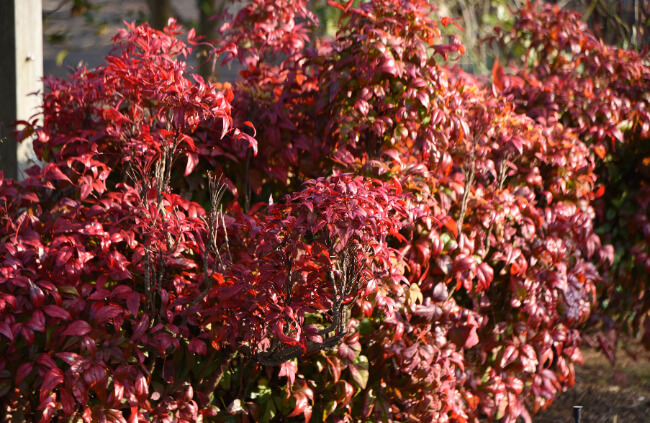
Ideal Conditions for Planting Nandina
Preparing the Right Soil and Drainage for Nandina
Average garden soil (anything that holds together when squeezed, but breaks apart again) is fine for nandina. Provided it doesn’t pool water, or create boggy conditions after light rainfall, these plants will cope.
If you do have boggy conditions, or very heavy, water-retentive clay, then mix in plenty of grit or sharp sand to the soil, and a good layer to the base of the planting hole too. Or, grow it in a pot, where the added height can make dwarf varieties look spectacularly structural.
Sun and Temperature
Nandina likes full sun, but temperature isn’t overly important. They will show signs of drought, and they can lose leaves excessively in very cold winters, but they nearly always recover without any intervention.
If your garden is south-facing, or you’ve got neighbouring trees shading out your borders, don’t worry too much. As long as Nandina domestica gets around six hours of direct light per day it will thrive.
In four hours of sunlight, it will be slow to establish, and may need regular trimming to stop it from going leggy, but it will still grow.
Water Requirements
Nandina needs watering in really thoroughly. Their fibrous mess of roots dry out the second they hit new soil, so give them a full bucket of water, regardless of the weather or soil conditions, as soon as you plant them.
After that, give them half a bucket every week for their first summer to help them establish (unless there has been heavy rain). In their second year, give them a gentle tug. They should offer good resistance, which shows they have rooted well.
At that point you can stop watering, unless there is a prolonged summer drought.
Growing Nandina in Pots
There are two reasons to plant Nandina in pots; avoiding heavy clay soil, and for ornament. Nandina are highly ornamental shrubs, and any dwarf varieties look especially good when raised up in pots and clipped into topiary balls or cubes.
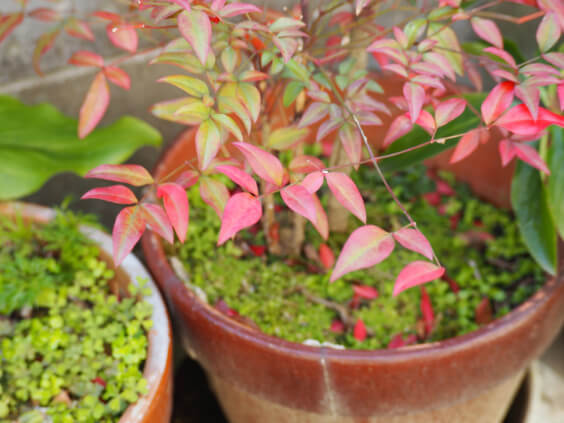
When planting any tree or shrub into a container, make sure it’s got a mix of nutrients, but also simple, basic, soil. Shrubs can stay in large containers for decades if they are paired to the container well, and soil holds and regenerated nutrients far better than compost.
- In the base of a large container (at least 50cm wide), add broken terracotta, polystyrene, or anything that will stop drainage holes from blocking up.
- Mix loamy soil (order in topsoil if you need to) with peat-free compost or leaf mould made from your own garden (60% soil, 40% organic matter), and half fill the container.
- Check that the surface of your current nandina container (the soil level) will sit about 2” below the rim of the new pot, and add or remove soil to get it just right.
- Tease out the roots of your nandina (don’t worry about breaking them, that just stimulates new growth) and plant it into its new home, filling around it with compost until the soil surface is level with the base of the plant, and 2” below the rim of the container.
- Water thoroughly, until water runs through the drainage holes and pools on the ground.
- If this compresses the compost, top it up again so the root ball is covered.
Propagating Nandina Domestica
Like any flowering plant, it is very possible to propagate nandina from seed, but it’s probably not worth your time, when it’s so quick and easy to get new plants from cuttings and layering.
Layering Nandina
The first method, layering, is simple. Just remove a small section of bark from last year’s growth, and pin it to the ground while it’s still attached to the plant. Cover it with soil, and wait for about twelve months.
In that time it should root, and have developed a new plant from that point which can be cut from the parent without taking up any space in pots around the garden.
Nandina Cuttings
Semi-ripe cuttings are the best method for nandina propagation. Take 10-15cm of a non-flowering shoot, from this year’s growth in late summer, and strip the base of the stem.
Poke the cutting into loose soil mixed 50:50 with perlite, and store it somewhere above 18°C. The cutting will root slowly before showing signs of growth, so be patient and store it somewhere bright and warm until next spring, when it should start to develop further.
How to Care for Nandina
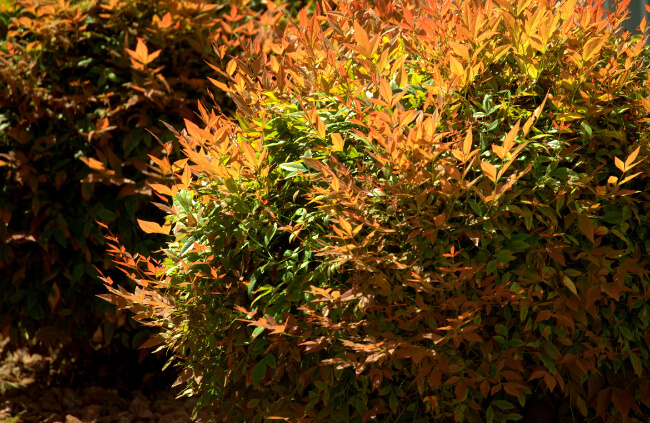
After planting any nandina, the ongoing care depends entirely on how you want it to look. Other than dwarf varieties, most nandinas can be trained into small trees, or left to develop into wild shrubs.
They can also be neatly topiarised, or turned into formal hedging. Dwarf varieties can form naturalistic mats, or impressively tight structures to line pathways.
Mulching
Nandina does benefit from a biennial mulch. If you have leaf litter or garden compost, add a 2” layer around the base of each plant, as wide as the canopy, every two years.
If you don’t make your own compost, any organic peat-free compost will work for this. Don’t use bark chips as this will lock in moisture without adding available nutrients.
Do I need to Fertilise Nandina?
There’s no real need to feed or fertilise Nandina, but if you don’t have space to mulch (if your Nandina is grown in pots for example), then sprinkle some slow release granular fertiliser (any balanced plant food will do) over the soil once a year according the packet instructions.
Pruning Nandina
Nandina can be pruned in so many ways that it’s probably worth an article in itself, but essentially, you can’t go wrong, unless you get carried away with shears.
Shearing any plant cuts both the leaves and stems, so you’ll lose the bristling effect of the dagger-shaped foliage. Cut back sensitively with secateurs, one branch at a time, whether you’re trying to create neat curves, or bare branches.
Nandina grows back from old growth, so you can literally cut the whole thing to the ground if needs be.
The only other note on Nandina pruning is about native birds. Nandina berries are toxic to birds if eaten in large quantities. If you do notice your garden birds eating these abundant berries in winter, consider removing them before they eat too much.
Repotting Nandina
Nandina don’t really mind being pot bound and can grow in quite tight spaces, but it’s worth lifting them from their pots every four or five years once they’re established and shaking the root ball off.
This gives some space to add new compost around the edge of the plant, and will trigger fresh feeding roots too.
Common Nandina Pests and Diseases
Spider mites and scale (cottony cushion scale in particular) are common problems with Nandina. The thin leaves are easy for them to pierce and feed on, and the speedy replenishment of damaged foliage by each plant means they always have a food source.
If you notice spider mites, soak the soil for a couple of weeks, and spray the plant with strong jets from a hose. Refer to our in-depth guide on how to deal with white spider mites for more details.
For scale, wipe them off and discard them, and hope for ladybugs to turn up, as they’ll eat whole populations of scale and mealybugs in just a few days.
There aren’t many diseases that commonly impact nandina in Australia, but mosaic virus can be troubling, causing a general patching of each leaf, making them look flushed and irritated.
Mosaic virus takes many forms, including Plantago asiatica mosaic virus, which is quite specific to Nandina, and the more common cucumber mosaic virus, which is easily spread around in gardens where veggies are also grown.
Nandina Domestica Frequently Asked Questions
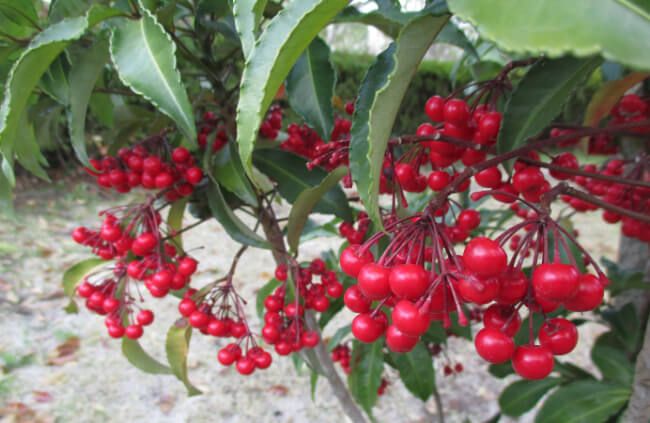
How tall will Nandina grow?
Nandina can grow to about 3m tall if left to naturalise, but are generally 1-2m. Dwarf varieties are more easily controlled, rarely growing taller than 2ft.
Do Nandina lose their leaves in winter?
Nandina only lose their leaves in winter if there is a severe frost over several weeks. In nearly all parts of Australia that means that they are basically evergreen shrubs, offering year round colour.
Is Nandina toxic to dogs?
Nandina is toxic to dogs, cats, horses, and most animals. Its berries are especially problematic for berry-eating birds through winter, when it is often the only available food source, and is toxic in large quantities.
What is the best time to prune Nandina?
The best time to prune Nandina is late winter, provided the temperature is reliably above freezing, and the days are starting to get longer. This encourages new spring growth, which will carry most of the colour for the following season.
What is the lifespan of Nandina?
Nandina domestica is a long-lived plant, lasting in historic collections for centuries. In my own life, I am aware of three large, 3m tall Nandina shrubs that were long-established when I was born, so are at least fifty years old.
Is Nandina frost hardy?
Nandina is frost hardy, but frosts will cause it to lose its leaves to some degree, and the longer the frost lasts, the more leaves it will lose. If this happens, just be patient, as the plant will recover when temperatures get back to normal.
Wrapping Up Our Nandina Domestica Guide
Nandina, Sacred Bamboo, Heavenly Bamboo, whatever you might call it, is a beautiful but challenging plant, not for its care, but for its potential impact on nature. If you do decide to grow nandina, make sure you keep a watchful eye out for feeding birds in winter, and remove any berries before they feast on them to avoid harming your local bird population.
If you can cope with that one basic task, then nandina is a very low maintenance shrub indeed, offering stunning, year-round colour to any garden, whether it’s in pots or you grow Nandina domestica to highlight your borders
Published on August 3, 2023 by Maisie Blevins
Last Updated on February 24, 2024

